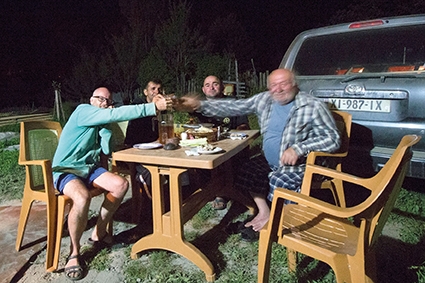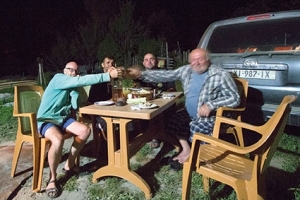Plaster Diary, 3: Etseri, Svaneti
Blog
Acouple more observations as we finish the house exterior after six years living here, continued from the last two weeks:
6) Realize that things will get messy before they are finished. The process of hurling trowels of cement at the walls causes spatters aplenty to rain down around and below (cover the windows!); all the woodcutting for the scaffolds and smaller pieces will leave scraps, which go into the “fire-starting wood” sacks for winter; sand will get tracked inside and scattered in the yard. Live with it, keeping the goal of a beautifully finished and weather-protected exterior firmly in mind. That last point is useful too: this is not just for esthetics, but more importantly for shielding the house from the ravages of snow, freeze, thaw and sun in their cycles, which can wreak havoc on the integrity of your walls’ cement blocks: real, dangerous structural damage! And even, as we found out last spring, an excess of snow sitting against the walls can penetrate right through the blocks’ thickness and begin to spoil the plaster work on those walls’ interior surfaces, with mold gathering… Always something to consider, this home ownership thing. Slowly, the house is moving towards its final completed state. Still to come, in our dreams: some decks; a big gazebo taking the place of balconies; an exterior staircase to the 2nd floor, this and the 1st-floor doorways to be better covered from snowfall off the roof; a sauna; good landscaping all ‘round. One step at a time.
7) Not only is there cleanup during the work, ongoing, but after it as well, because craftsmen here don’t clean up after themselves, as a rule, expecting their hosts to do it. As long as everybody knows this, there are no disappointments! Once they remove the scaffolding, there will be holes in the ground to fill from the tall posts. Plastic sheeting from the covered windows. Cut off bits of foam from installing the windows some years ago. Bottles, bags… and so on. It’s part of the process.
Day 10: Those vertical cement ribs which they make up the walls before filling in the spaces around them into a smoother plane? Those are to guide the wood planks which they use to scrape up the walls and keep everything to that plane. So they’re key, and installed with care using plumb-lines and levels, foundational as they are. And then, purpose fulfilled, they disappear under the surrounding material as it fills in around them. The final cement finish over all this is smoother still, filling in all holes and drying before the final finish layer of “brizgi”, as it’s called, plaster and colorant applied with a spinning hand-held apparatus. We plan a darker layer going from the ground to between the two floors, with a lighter one above that, to break things up a bit.
Day 16: After two days away getting a car tune-up and some much-needed repairs in Kobuleti’s convenient Toyota Center, I came back to find that they had begun applying the final, textured plaster, layer to the front face of the house, to show me what to expect. It’s on the top half, and cream colored; the lower level will be darker, a sharp line between the two, for a two-tone finish on all sides. Looks very good, and we’re looking forward to seeing the whole thing finished in a week or so. The house and we have waited a long time for this beautifying and weather-protecting process, one of the longest in actual work time required and most expensive single things we have done to this place, in both materials and labor. It’s all worth it. The time to celebrate approaches!
Tony Hanmer has lived in Georgia since 1999, in Svaneti since 2007, and been a weekly writer for GT since early 2011. He runs the “Svaneti Renaissance” Facebook group, now with over 1900 members, at www.facebook.com/groups/SvanetiRenaissance/
He and his wife also run their own guest house in Etseri:
www.facebook.com/hanmer.house.svaneti
By Tony Hanmer












